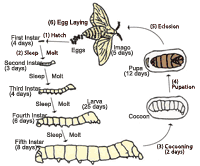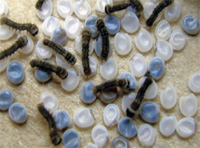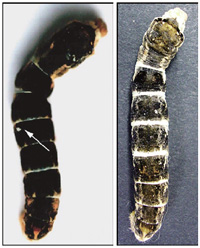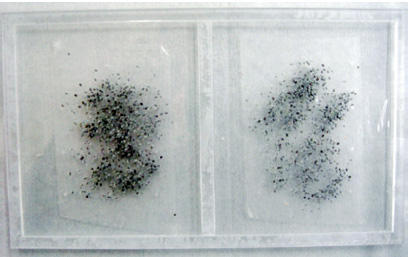This is an archive of information released in the past.
Disclaimer: It may contain broken links or outdated information. Some parts may not function in current web browsers.
*Visit https://humans-in-space.jaxa.jp/en/ for the latest information.

Experiment
- News
- Kibo Utilization Strategy
- Kibo Utilization Plan
- List of JAXA's Utilization Themes
- Experiment Facilities
- Space Environment Utilization
- Archive
News
- Experiment successfully completed (November 25, 2009)
Background

Figure 1. The Life Cycle of a Silkworm

Figure 2. Silkworm Eggs and Hatching
We have a long history with silkworms (Figures 1 and 2). They are mentioned in The Kojiki, known in English as The Records of Ancient Matters. Silk textile manufacturing, which uses silk from silkworm cocoons, is a traditional industry of Japan. In science, silkworms are used as model organisms in genetics and physiology, with many known mutants. Experiments with silkworms are one of Japan's specialties.
While many studies on the effects of space radiation use cellular experiments, experiments with silkworms examine individual organisms. In this experiment, overwintering, or diapausing, eggs placed in customized egg cases will be delivered to the International Space Station (ISS) to have them develop embryos in space. Then, the eggs will be returned to Earth and their life cycles, from eggs to hatched larvae, pupae and imagoes, will be observed on the ground.
In 1997, an experiment with silkworm eggs was conducted to examine hatchability and teratogenicity aboard the Space Shuttle on the STS-84 Mission. Malformations, such as mottles and constricted segments, occurred twice as often as with silkworm eggs on Earth.
In preparation for this experiment, ground-based experiments in which silkworm eggs were exposed to simulated space radiation were repeatedly conducted. The experiment showed that radiation at an early stage, especially on the second and third days, of embryonic development caused a high rate of mutation.
The Rad Silk experiment is designed to see what will happen to silkworms if they are exposed to space radiation at an early stage of embryonic development in space. Individual variations and genetic changes may identify the effects of space radiation at each developmental stage.
Objectives

Figure 3. Silkworms Exposed to Radiation
A major purpose of the Rad Silk experiment is to identify the effects of space radiation at an early stage of development on silkworm eggs.
During the ground-based experiment, the silkworm eggs (a black-skinned strain) exposed to radiation developed white spots on their bodies (a mutation). The higher the level and energy of radiation are, the more larvae with white spots are produced (Figure 3).
Findings with silkworms can not directly apply to humans because they do not hatch from eggs. Still, they share the basic mechanism by which genes produce proteins. This is why this experiment will study the effects of space radiation on genes that work during embryonic development.
The white spots on silkworms, which appear when exposed to radiation during their early developmental stages, are a visually recognizable change. The level of radiation exposure in the spacecraft can be roughly estimated based on the number of larvae with white spots on them. Thus, it will be possible to use those spots as a "measure" for radiation exposure. The Rad Silk experiment will also explore this possibility.
Experiments

Figure 4. The Container of Silkworm Eggs for the Space Experiment
Silkworm diapausing eggs will be delivered at 4°C (Figure 4). In space, they will be incubated at 20°C to have them develop their embryos. Cell division will start and organs will be formed. Ground-based experiments have shown that radiation greatly affects eggs during the early stage of embryo developments.
The eggs will be brought back to Earth in either one of two groups: one in which eggs will be refrigerated and one in which eggs will be frozen. Refrigerated eggs will be germinated on Earth. They will be observed for subsequent growth and effects on the next generation. Frozen eggs will be used for genetic analysis to determine which genes will be expressed to produce proteins.
Main Points of This Experiment !
Since silkworm eggs are very small-about 0.8 mm in longer diameter, 0.5 mm in shorter diameter and 0.3 mm in thickness-they can be delivered in large quantities. Therefore, they will allow for probabilistic analysis and provide reliable data. In addition, it will be possible to comprehensively assess the effects of space radiation at cellular, molecular, and individual levels by examining their life cycles from eggs to hatches of the next generation.
It is expected that "biological measurements" of radiation doses based on "biological effects" will be established by associating the effects with "physical measurements" of the types and levels of radiation exposure in the spacecraft.
Organization
 |
Principal Investigator (PI)
Toshiharu FURUSAWA Kinugasa-kai Foundation Kinugasa Textile Research Institute, Professor Emeritus, Kyoto Institute of Technology |
| Copyright 2007 Japan Aerospace Exploration Agency | Site Policy |